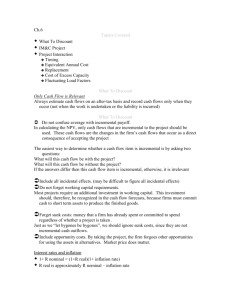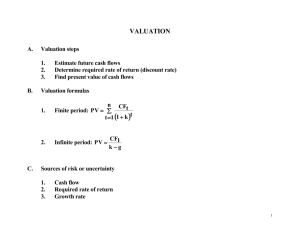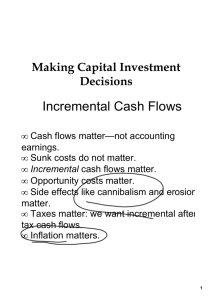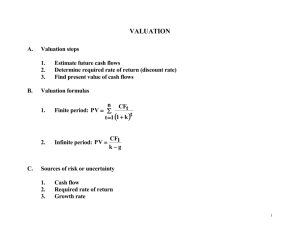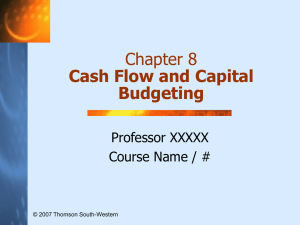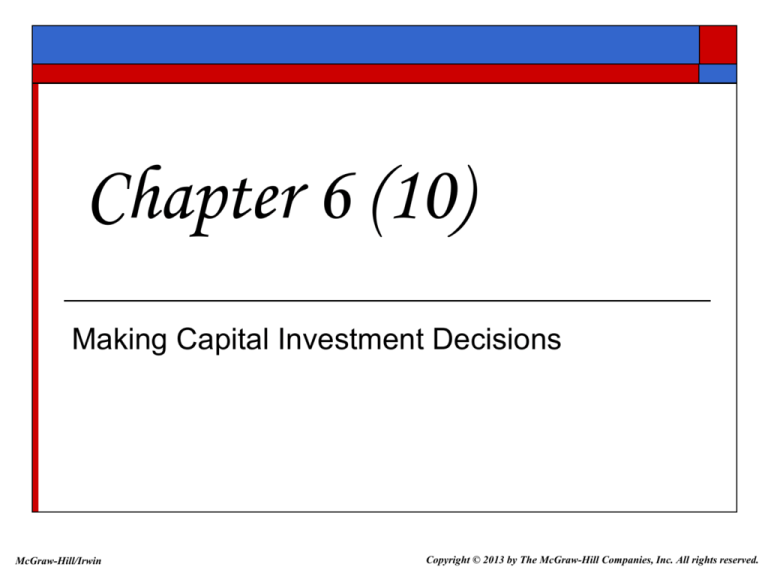
Chapter 6 (10)
Making Capital Investment Decisions
McGraw-Hill/Irwin
Copyright © 2013 by The McGraw-Hill Companies, Inc. All rights reserved.
Key Concepts and Skills
Understand how to determine the relevant cash
flows for various types of capital investments
Be able to compute depreciation expense for
tax purposes
Incorporate inflation into capital budgeting
Understand the various methods for computing
operating cash flow
Evaluate special cases of discounted cash flow
analysis
6-1
Chapter Outline
6.1 Incremental Cash Flows
6.2 The Baldwin Company: An Example
6.3 Inflation and Capital Budgeting
6.4 Alternative Definitions of Operating Cash
Flow
6.5 Some Special Cases of Discounted Cash Flow
Analysis
6-2
6.1 Incremental Cash Flows
Cash flows matter—not accounting earnings.
Sunk costs do not matter.
Incremental cash flows matter.
Opportunity costs matter.
Side effects like cannibalism and erosion
matter.
Taxes matter: we want incremental after-tax
cash flows.
Inflation matters.
6-3
Cash Flows—Not Accounting Income
Consider
depreciation expense.
You
never write a check made out to
“depreciation.”
Much
of the work in evaluating a project
lies in taking accounting numbers and
generating cash flows.
6-4
Incremental Cash Flows
Sunk costs are not relevant
Just because “we have come this far” does not
mean that we should continue to throw good
money after bad.
Opportunity costs do matter. Just because a
project has a positive NPV, that does not mean
that it should also have automatic acceptance.
Specifically, if another project with a higher
NPV would have to be passed up, then we
should not proceed.
6-5
Incremental Cash Flows
Side
effects matter.
Erosion
is a “bad” thing. If our new product
causes existing customers to demand less of
our current products, we need to recognize
that.
If, however, synergies result that create
increased demand of existing products, we
also need to recognize that.
6-6
Estimating Cash Flows
Cash Flow from Operations
Net Capital Spending
Recall that:
OCF = EBIT – Taxes + Depreciation
Do not forget salvage value (after tax, of course).
Changes in Net Working Capital
Recall that when the project winds down, we enjoy
a return of net working capital.
6-7
Interest Expense
Later
chapters will deal with the impact
that the amount of debt that a firm has in
its capital structure has on firm value.
For now, it is enough to assume that the
firm’s level of debt (and, hence, interest
expense) is independent of the project at
hand.
6-8
6.2 The Baldwin Company
Costs of test marketing (already spent): $250,000
Current market value of proposed factory site
(which we own): $150,000
Cost of bowling ball machine: $100,000
(depreciated according to Modified Accelerated
Cost Recovery System [MACRS] 5-year)
Increase in net working capital: $10,000
Production (in units) by year during 5-year life
of the machine: 5,000, 8,000, 12,000, 10,000,
6,000
6-9
The Baldwin Company
Price during first year is $20; price increases
2% per year thereafter.
Production costs during first year are $10 per
unit and increase 10% per year thereafter.
Annual inflation rate: 5%
Working Capital: initial $10,000 changes with
sales
6-10
The Baldwin Company
($ thousands) (All cash flows occur at the end of the year.)
Year 0
Year 1
Investments:
(1) Bowling ball machine
–100.00
(2) Accumulated
20.00
depreciation
(3) Adjusted basis of
80.00
machine after
depreciation (end of year)
(4) Opportunity cost
–150.00
(warehouse)
(5) Net working capital
10.00 10.00
(end of year)
(6) Change in net
–10.00
working capital
(7) Total cash flow of
–260.00
investment
[(1) + (4) + (6)]
Year 2
Year 3
Year 4 Year 5
52.00
71.20
82.72
21.76*
94.24
48.00
28.80
17.28
5.76
150.00
16.32
24.97
21.22
0
–6.32
–8.65
3.75
21.22
–6.32
–8.65
3.75
192.98
6-11
The Baldwin Company
Year 0
Year 1
Investments:
(1) Bowling ball machine
–100.00
(2) Accumulated
20.00
depreciation
(3) Adjusted basis of
80.00
machine after
depreciation (end of year)
(4) Opportunity cost
–150.00
(warehouse)
(5) Net working capital
10.00 10.00
(end of year)
(6) Change in net
–10.00
working capital
(7) Total cash flow of
–260.00
investment
[(1) + (4) + (6)]
Year 2
Year 3
Year 4 Year 5
52.00
71.20
82.72
21.76
94.24
48.00
28.80
17.28
5.76
150.00
16.32
24.97
21.22
0
–6.32
–8.65
3.75
21.22
–6.32
–8.65
3.75
192.98
At the end of the project, the warehouse is unencumbered, so we can sell it if we want to.
6-12
The Baldwin Company
Year 0 Year 1 Year 2 Year 3 Year 4 Year 5
Income:
(8) Sales Revenues
100.00 163.20 249.70 212.24 129.89
Recall that production (in units) by year during the 5-year life of the machine is
given by:
(5,000, 8,000, 12,000, 10,000, 6,000).
Price during the first year is $20 and increases 2% per year thereafter.
Sales revenue in year 2 = 8,000×[$20×(1.02)1] = 8,000×$20.40 = $163,200.
6-13
The Baldwin Company
Year 0 Year 1 Year 2 Year 3 Year 4
Income:
(8) Sales Revenues
(9) Operating costs
Year 5
100.00 163.20 249.70 212.24 129.89
50.00 88.00 145.20 133.10 87.85
Again, production (in units) by year during 5-year life of the machine is given
by:
(5,000, 8,000, 12,000, 10,000, 6,000).
Production costs during the first year (per unit) are $10, and they increase
10% per year thereafter.
Production costs in year 2 = 8,000×[$10×(1.10)1] = $88,000
6-14
The Baldwin Company
Year 0 Year 1 Year 2 Year 3 Year 4
Income:
(8) Sales Revenues
(9) Operating costs
(10) Depreciation
Year 5
100.00 163.20 249.70 212.24 129.89
50.00 88.00 145.20 133.10 87.85
20.00 32.00 19.20 11.52 11.52
Depreciation is calculated using the Modified
Accelerated Cost Recovery System (shown at
right).
Our cost basis is $100,000.
Depreciation charge in year 4
= $100,000×(.1152) = $11,520.
Year
ACRS %
1
20.00%
2
32.00%
3
19.20%
4
11.52%
5
11.52%
6
5.76%
Total 100.00%
6-15
The Baldwin Company
Year 0 Year 1 Year 2 Year 3 Year 4 Year 5
Income:
(8) Sales Revenues
(9) Operating costs
(10) Depreciation
(11) Income before taxes
[(8) – (9) - (10)]
(12) Tax at 34 percent
(13) Net Income
100.00 163.20 249.70 212.24 129.89
50.00 88.00 145.20 133.10 87.85
20.00 32.00 19.20 11.52 11.52
30.00 43.20 85.30 67.62 30.53
10.20
19.80
14.69
28.51
29.00
56.30
22.99
44.63
10.38
20.15
6-16
Incremental After Tax Cash Flows (IATCF)
Year 0
(1) Sales
Revenues
(2) Operating
costs
(3) Taxes
(4) OCF
(1) – (2) – (3)
(5) Total CF of
Investment
(6) IATCF
[(4) + (5)]
Year 1
Year 2
Year 3
Year 4
Year 5
$100.00
$163.20
$249.70
$212.24
$129.89
-50.00
-88.00
-145.20
-133.10
-87.85
-10.20
-14.69
-29.00
-22.99
-10.38
39.80
60.51
75.50
56.15
31.67
–6.32
–8.65
3.75
192.98
54.19
66.85
59.90
224.65
–260.
–260.
39.80
$39.80 $54.19 $66.85 $59.90 $224.65
NPV $260
2
3
4
(1.10) (1.10) (1.10) (1.10)
(1.10)5
NPV $51.59
6-17
7.3 Inflation and Capital Budgeting
Inflation is an important fact of economic life
and must be considered in capital budgeting.
Consider the relationship between interest
rates and inflation, often referred to as the
Fisher equation:
(1 + Nominal Rate) = (1 + Real Rate) × (1 + Inflation Rate)
6-18
Inflation and Capital Budgeting
For low rates of inflation, this is often approximated:
Real Rate Nominal Rate – Inflation Rate
While the nominal rate in the U.S. has fluctuated
with inflation, the real rate has generally exhibited
far less variance than the nominal rate.
In capital budgeting, one must compare real cash
flows discounted at real rates or nominal cash flows
discounted at nominal rates.
6-19
Quick Quiz
How do we determine if cash flows are
relevant to the capital budgeting decision?
How should cash flows and discount rates be
matched when inflation is present?
6-20

